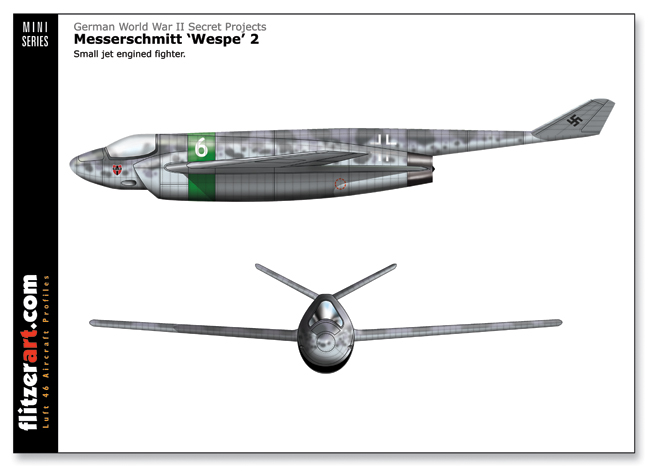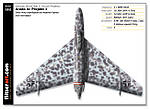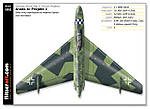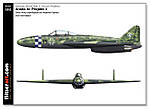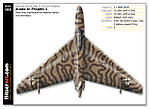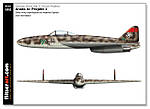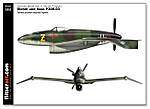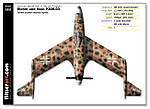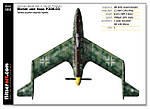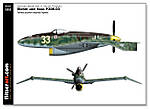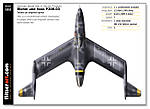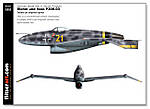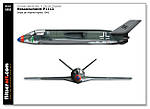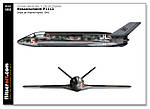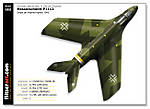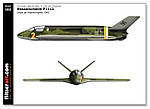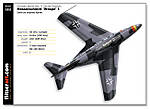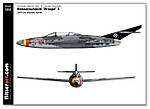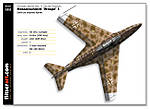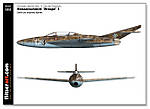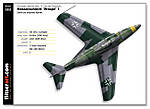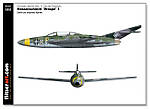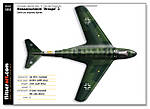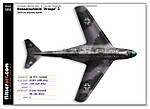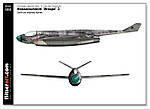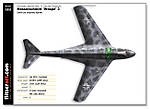German WW2 Secret Projects Vol. 2
12
Comments
After a layoff of around twelve months, this new set picks up where we left off last time with a fresh batch of German secret projects of WW2. And as previously Iíve revisited and reworked some earlier profiles plus added a few completely new ones. Please note that all colours used in the profiles are standard RLM colours or derived from mixing them for shades and new colours that may have been evident due to the methods of application and the paint supply circumstances in the latter part of WW2.
Please see Luft 46 Colour Camouflage Applications, Part 1: Fighters for a full explanation.
There is some conjecture to the number of crew, some sources state three whilst others suggest two. And one source suggests a single seat interceptor development may have been considered, probably based on the smaller first design. After completing the profiles with a two man cockpit, I now believe the 3 seater is probably correct. Due to the, at the time, novel design and war time constraints, the RLM considered too much development and testing time would have been needed to achieve its full potential thus all further work was ceased in favour of the Arado E. 583.06 Projekt 2.
Originally armament was to consist of ten Mk108 30mm cannon, but this seems to have been reduced to, a still impressive, eight. Four forward-firing mounted in the nose, two rearward-firing mounted in the tail and two mounted in the rear upper fuselage firing obliquely upwards at 70 degrees.
I have done four profiles, one in a more conventional night-fighter scheme, another night-fighter scheme using RLM 76 and Rlm02, one using the factory base undercoat green as the foundation colour with the fourth in shades of grey-brown mirror wave pattern.
Power was provided by a single Daimler Benz 12-cylinder DB 603L engine modified to accept a two-stage supercharger (2100 HP with MW 50 methanol-water injection). The engine was buried in the rear fuselage engaging a 4 blade pusher propeller. Originally the design series planned to use a single jet engine which proved to be too late to have been ready in time, hence the adoption of the DB603L instead for the .03 version. Armament was to be three nose mounted MK 108 30mm cannon.
Blohm und Voss used a similar wing design concept for numerous subsequent designs, including the P209.01, P210, P212 and P215.
I have done four profiles, three with the pusher prop engine and one to illustrate what the turbojet version may have looked like.
The second designís cockpit was located much further forward in the fuselage and the He S 011 turbojet was mounted mid fuselage. It was fed by an air duct which wrapped under the forward fuselage, and exhausted below the tail boom. A V- Tail unit sat at the end of the boom.
Both designs 1 and 2 used tricycle landing gear and although no armament was specified, two MK 108 30mm cannon would probably have been fitted in the nose.
The project's final design featured a 40 degree swept-back wing and power was to be provided by a single He S 011A jet engine with a view to upgrade and adopt the more powerful He S 011B engine when it became available. Two air intakes were located on each side of the fuselage above the wing roots. The tail unit was a V-tail to help reduce the surface area and thus reduce drag.
The armament consisted of four MK 108 30mm cannon which were located on the fuselage sides surrounding the cockpit. Two 30mm MK 103 cannon could be fitted in place of two of the MK 108 cannon. A very unusual mounting of either one MK 112 55mm cannon, mounted in the lower fuselage sides, or one Mk 214 50mm cannon (see drawing below) could be accommodated by the barrel protruding through the front canopy.
Allied troops overran the Oberrammergau workshops where the P1112 was being developed in April, 1945 and shortly thereafter took possession of all files relating to the P.1112. It is no coincidence that the U.S. Navy Chance Vought F7U-1 "Cutlass" wing shares similar features to those of the P.1112. And by no coincidence Waldemar Voigt, the head of the P1112 project, found employment with Chance Vought after the war.
Thatís it for now, more coming soon.
Dan Johnsonís Luft 46 site: www.luft46.com
Luftwaffe Secret Projects: Fighters 1939-1945 by Walter Schick, Ingolf Meyer, Elke Weal, and John Weal
Luftwaffe Secret Projects: Strategic Bombers 1935-1945 by Dieter Herwig
Luftwaffe Secret Projects, Volume 3: Ground Attack & Special Purpose Aircraft by Dieter Herwig
Jet Planes of the Third Reich Vols 1 and 2 by Manfred Griel
Please see Luft 46 Colour Camouflage Applications, Part 1: Fighters for a full explanation.
Arado E.583.05 (Projekt 1)
More commonly known as the P1 or Projekt 1, this aircraft was a new design by Arado for a Night/Bad Weather Fighter and Zerstorer/Interceptor. The first draught was for a somewhat smaller aircraft featuring a full delta wing, but grew in to the final design as illustrated. I may well include the first design in a future set of profiles. Designed for the simplest of manufacturing procedures, it was a swept delta winged, twin engined concept. The 2 HeS 011A jets were housed in a common nacelle under the rear fuselage. The wings had twin fins and rudders two thirds from the fuselage centre line.There is some conjecture to the number of crew, some sources state three whilst others suggest two. And one source suggests a single seat interceptor development may have been considered, probably based on the smaller first design. After completing the profiles with a two man cockpit, I now believe the 3 seater is probably correct. Due to the, at the time, novel design and war time constraints, the RLM considered too much development and testing time would have been needed to achieve its full potential thus all further work was ceased in favour of the Arado E. 583.06 Projekt 2.
Originally armament was to consist of ten Mk108 30mm cannon, but this seems to have been reduced to, a still impressive, eight. Four forward-firing mounted in the nose, two rearward-firing mounted in the tail and two mounted in the rear upper fuselage firing obliquely upwards at 70 degrees.
I have done four profiles, one in a more conventional night-fighter scheme, another night-fighter scheme using RLM 76 and Rlm02, one using the factory base undercoat green as the foundation colour with the fourth in shades of grey-brown mirror wave pattern.
Blohm und Voss P208.03
After extensive testing using the Skoda-Kauba V-6 to validate the control practicality of the layout, Blohm und Voss produced a number of tailless designs, culminating in the P208.03. This design featured cantilevered wings with a sweep of 30 degrees which were of a constant cross section. Wingtips, acting as elevators and rudders, were angled downwards and connected aft of the main wing trailing edge by small booms.Power was provided by a single Daimler Benz 12-cylinder DB 603L engine modified to accept a two-stage supercharger (2100 HP with MW 50 methanol-water injection). The engine was buried in the rear fuselage engaging a 4 blade pusher propeller. Originally the design series planned to use a single jet engine which proved to be too late to have been ready in time, hence the adoption of the DB603L instead for the .03 version. Armament was to be three nose mounted MK 108 30mm cannon.
Blohm und Voss used a similar wing design concept for numerous subsequent designs, including the P209.01, P210, P212 and P215.
I have done four profiles, three with the pusher prop engine and one to illustrate what the turbojet version may have looked like.
Messerschmitt Wespe Mk 1
A largely unknown design that was penned in the late stages of WW2, Messerschmitt produced two ĎWespeí versions, each with a different fuselage. The first design, illustrated here, placed the cockpit midway along the fuselage, with a single He S 011 jet engine located to the rear, fed by a long air duct that started tucked under the nose. The tail was a long tapering fin and rudder, with the tail planes positioned mid-fin.The second designís cockpit was located much further forward in the fuselage and the He S 011 turbojet was mounted mid fuselage. It was fed by an air duct which wrapped under the forward fuselage, and exhausted below the tail boom. A V- Tail unit sat at the end of the boom.
Messerschmitt Wespe Mk 2
The cockpit on the second design was located far forward on the fuselage. The single He S 011 turbojet was mounted mid-ships fed by an air duct which wrapped under the forward fuselage, and exhausted below a tail boom with a V- Tail unit.Both designs 1 and 2 used tricycle landing gear and although no armament was specified, two MK 108 30mm cannon would probably have been fitted in the nose.
Messerschmitt P1112
Work began on the P1112 project in early 1945, to build and develop the previous P1111 design, principally to eradicate design deficiencies and further improve what would have been a very futuristic concept. The design saw many design changes before arriving at the final version, illustrated here.The project's final design featured a 40 degree swept-back wing and power was to be provided by a single He S 011A jet engine with a view to upgrade and adopt the more powerful He S 011B engine when it became available. Two air intakes were located on each side of the fuselage above the wing roots. The tail unit was a V-tail to help reduce the surface area and thus reduce drag.
The armament consisted of four MK 108 30mm cannon which were located on the fuselage sides surrounding the cockpit. Two 30mm MK 103 cannon could be fitted in place of two of the MK 108 cannon. A very unusual mounting of either one MK 112 55mm cannon, mounted in the lower fuselage sides, or one Mk 214 50mm cannon (see drawing below) could be accommodated by the barrel protruding through the front canopy.
Allied troops overran the Oberrammergau workshops where the P1112 was being developed in April, 1945 and shortly thereafter took possession of all files relating to the P.1112. It is no coincidence that the U.S. Navy Chance Vought F7U-1 "Cutlass" wing shares similar features to those of the P.1112. And by no coincidence Waldemar Voigt, the head of the P1112 project, found employment with Chance Vought after the war.
Thatís it for now, more coming soon.
References
The following references proved invaluable in helping me to produce these profiles.Dan Johnsonís Luft 46 site: www.luft46.com
Luftwaffe Secret Projects: Fighters 1939-1945 by Walter Schick, Ingolf Meyer, Elke Weal, and John Weal
Luftwaffe Secret Projects: Strategic Bombers 1935-1945 by Dieter Herwig
Luftwaffe Secret Projects, Volume 3: Ground Attack & Special Purpose Aircraft by Dieter Herwig
Jet Planes of the Third Reich Vols 1 and 2 by Manfred Griel
Comments
Many thanks to Merlin for getting this up on site so-o-o-o Quickly.
I only sent the zip file yesterday afternoon.
Now that is what I call service...
I'm ready to start the next batch but can't decide whether to do another set of German WW2 profiles or another one of WW2 British ones.
Once again Many many thanks to Rowan.
Cheers
Peter
APR 20, 2008 - 01:37 AM
Peter, looks absolutely great - as always. It is great inspiration for my Luft '46 projects. I have the Me 1101, Horten wing, Triebvogel etc. in my stash.
Thanks for sharing
Have you ever considered to make book with all your profiles and short histories of the designs? I know this would be "unscientific" and based largely on speculation. But I think it could still be interesting for many - especially considering the interest there is in experimental or luft '46 kits.
To save cost you might sell it as a PDF file online. Just a thought...
APR 22, 2008 - 10:52 PM
Hi Jesper,
glad you liked them. Makes doing them even more worthwhile.
On publishing them...in the past a number of members have encouraged me to do the same, and I actually enquired at a few publishers but all turned me down flat.
I have no plans other than to keep on doing them, posting them here and on my web-site. Although producing them myself as you say, as pdf on-line might be a good idea if I could find the time...lol.
Worth thinking about.
Many thanks again.
Cheers
Peter
APR 23, 2008 - 09:46 PM
Yippee...... Flitzer's Back.....
My trucks and buses are getting lonely.
APR 23, 2008 - 11:54 PM
Hi Dave
I'll try my best to prevent the necessity for a bus and trucks lonely hearts club.
(I don't know what's wrong with me today...it's taken ages to type this. Keep getting typos...must take off my boxing gloves when I'm typing.)
All the best
Peter
APR 24, 2008 - 04:06 AM
That could be cool. I believe there is a "silent mass" that would be very interested.
Under all circumstances, thanks for your effort
APR 24, 2008 - 08:15 PM
MAY 21, 2008 - 08:11 PM
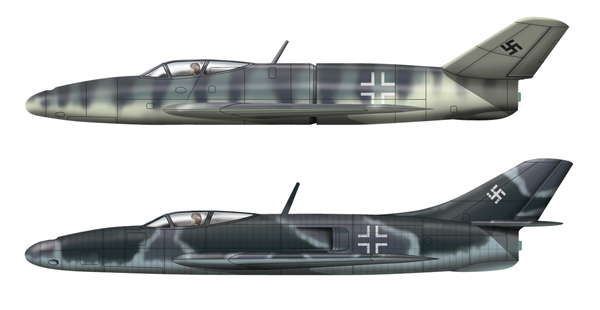 Here you go Peter.
To post pics in the Forum, just copy the files properties and paste them where indicated when you click on the [img] button above the emoticons.
All the best
Rowan
Here you go Peter.
To post pics in the Forum, just copy the files properties and paste them where indicated when you click on the [img] button above the emoticons.
All the best
Rowan MAY 24, 2008 - 01:27 AM
Fine work, as per usual. Good to have you back in such style.
Cheers
JUL 18, 2008 - 07:03 PM
Copyright ©2021 by Peter Allen. Images also by copyright holder unless otherwise noted. The views and opinions expressed herein are solely the views and opinions of the authors and/or contributors to this Web site and do not necessarily represent the views and/or opinions of AeroScale, KitMaker Network, or Silver Star Enterrpises. Images also by copyright holder unless otherwise noted. Opinions expressed are those of the author(s) and not necessarily those of AeroScale. All rights reserved. Originally published on: 2008-04-20 00:00:00. Unique Reads: 33590




